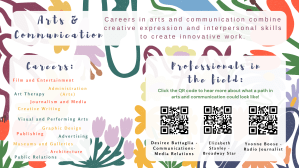Setting Up a Learning Hub to Innovate Instruction
High school teachers can support engagement and innovation with STEAM and career-focused activities that tap into students’ curiosity.
Your content has been saved!
Go to My Saved Content.When you walk into many schools these days, you will encounter updated 21st-century learning spaces with makerspace equipment, flexible seats, and projectors—all with the goal of providing space for students to innovate, create, explore their interests, build on their curiosities, and connect with the world around them. Once your school invests in updating this space, though, how do you create the culture and the programming to have students and staff utilize the space in the way it was designed?
At my school, our Learning and Innovation Hub is an incredible space with areas to host classrooms, breakout rooms to support collaboration, and flexible seats to encourage collaboration—and it’s equipped with whiteboards and projectors. I’m going to share some of the things we’ve been doing so that you can replicate some or all of these items in your space to ensure that your 21st-century learning spaces are functioning the way you want them to.
How to Incorporate STEAM Challenges
Every month, we host STEAM (science, technology, engineering, arts, and mathematics) challenges in our space during all lunch periods. These challenges serve as fun, low-stakes opportunities for any student to use their critical thinking skills. One day a month, the challenge materials are set up on a few tables in the Hub, where all students are invited to participate in the challenge. To encourage students to participate, we choose challenges that any student would be interested in, like paper airplanes and catapults.
These challenges are also low-prep, so they are easy to maintain and set up because the materials don’t cost a lot of money and don’t require any equipment. Students can work on these activities independently or with their peers. I was inspired to do monthly STEAM challenges when I first started at my school after seeing Maker Maven’s STEM challenges. Here are some examples of what we’ve done in the last year:
- Can you make your own 1-minute stop animation?
- Can you make a game out of a box lid?
- Can you build a desktop siege engine to topple the card castle?
Include a Monthly Pathway Focus for Students’ Future
To expose students to the many different college and career avenues they can take once they leave high school, we highlight a different pathway every month. The pathways have included manufacturing, engineering, technology, trades, finance and business services, health sciences and technology, information technology, arts and communication, and human and public services, as well as agriculture, food, and natural resources.
Each month, we design activities and bring in guest speakers from both school and the community, all with the goal of exposing our students to as many opportunities as possible. For every month, I created a screensaver to have on our TVs in the Hub that provides a brief overview of the pathway, potential careers within the pathway, and a QR code to a list of professionals in the field that students can hear from. Below is the screensaver for the arts and communication pathway:

For the arts and communication month in particular, we’re hosting blackout poetry days, “Color your stress away” coloring days, and button and sticker making. Blackout poetry involves taking a piece of writing (e.g., a page from a book, magazine, or newspaper, or a letter) and redacting words to create something new. One of the first pieces of equipment we purchased was a button press, so that students can design and create buttons, and we also have a silhouette cutter for students to design and create stickers.
We’re bringing in a poet for a virtual visit, and we are hosting a panel with design thinking professionals. The guest speakers will share how they found their path, how they dealt with adversity along the way, and some of the skills that were essential to their success. We bring in several local community members to share their experiences, and this can lead to networking opportunities for students.
Offer a Menu for Partnership With Teachers
In addition to facilitating challenges and bringing awareness to various pathways after high school, my other focus is partnering with teachers and bringing them into this incredible space as well.
At the beginning of the year, I created a menu for staff to outline all the ways I could support their classes, such as facilitating “speed dating” for independent reading, creating a gallery walk for engagement, providing lessons on research techniques and credibility, and hosting a personalized challenge for their class and content. “Speed dating” refers to students spending 5 minutes at a table with 15–20 novels in a specific genre. During those 5 minutes, students peruse all the books to see which ones spark their interest. The goal is for them to leave with at least one book and have a list of books to read in the future. The menu provides a starting point for teachers to have options for how to utilize a new space.
In addition to creating the menu, I either visited each department or sent an email listing specific ways for that department to utilize the Hub. It was important for me to explicitly share some ideas with each content area for how they could utilize the space. For example, I let the math department know that they could use window markers on our windows for increased vertical space when students practice their learning. After I shared these ideas with each department, the number of teachers reaching out to me to utilize the space increased immensely. Now, I have at least one teacher per day utilizing the space for instructional purposes.
After you’ve learned a little bit about what we do in our space, is there anything that sparks your interest? What can you do in your space to provide similar opportunities for students to explore their interests and possibly find their path?
